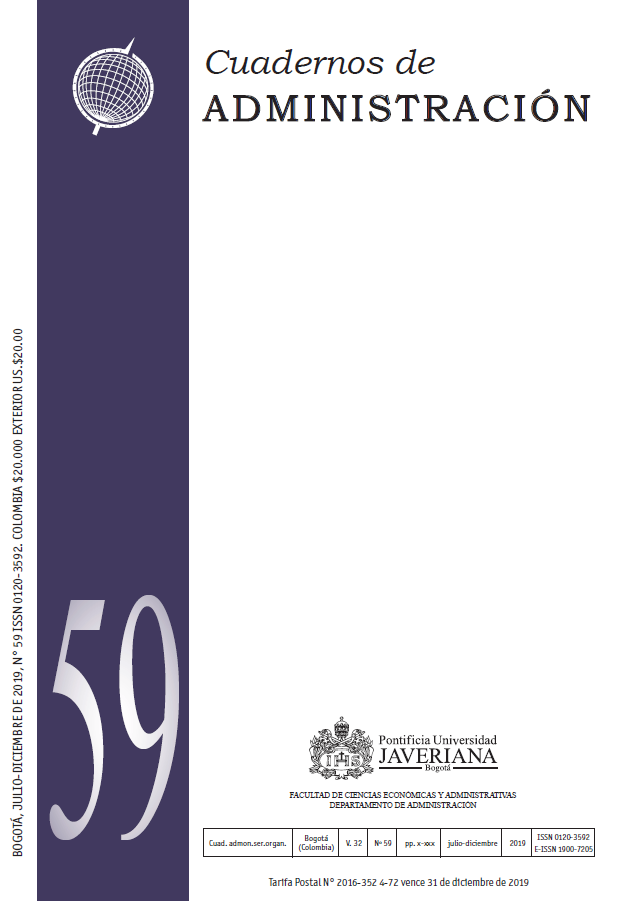Resumen
Indagamos en las fuentes de financiamiento para actividades de innovación en Colombia. El propósito principal es identificar el tipo de estructura de capital que adoptan las empresas que emprenden actividades de I + D, ya sea que esas empresas se ajusten a una estructura de orden jerárquico (POT por sus siglas en inglés) o a una estructura de capital de orden jerárquico alterada. Utilizamos una metodología probit multivariada y nuestro principal resultado es el hecho de que las empresas innovadoras en Colombia muestran la tendencia a financiar sus emprendimientos de innovación a través de una estructura de capital como la que se plantea en el POT. Nuestros resultados refuerzan el hecho de que las empresas innovadoras de los países subdesarrollados son, en cierta medida, diferentes a aquellas de los países desarrollados y, por consiguiente, las estrategias y políticas dirigidas a superar las barreras financieras en las naciones subdesarrolladas deben ser diferentes de aquellas diseñadas para los países desarrollados.
Aghion, P., Bond, S., Klemm, A., & Marinescu, I. (2004). Technology and financial structure: Are innovative firms different? Journal of the European Economic Association, 2, 277-288.
Arundel, A. (1997). Enterprise strategies and barriers to innovation. Innovation Measurement and Policies., Volume 50, 101-108.
Arundel, A., Bordoy, C., Mohnen, P., & Smith, K. H. (2008). Surveys and policy: lessons from the CIS.
Audretsch, D. B., & Lehmann, E. E. (2004). Financing High Tech Growth. Schmalenbach Business Review, 56, 340-357.
Baldwin, J., & Lin, Z. (2002). Impediments to advanced technology adoption for Canadian manufacturers. Research policy, 31(1), 1-18.
Bartolini, E. (2013). Capital structure and innovation: causality and determinants. Empirica, 40(1), 111-151.
Cappellari, L., & Jenkins, S. P. (2003). Multivariate probit regression using simulated maximum likelihood. The Stata Journal, 3(3), 278-294.
Colombo, M. G., & Grilli, L. (2007). Funding gaps? Access to bank loans by high-tech start-ups. Small Business Economics, 29(1-2), 25-46.
D'Este, P., Iammarino, S., Savona, M., & Von Tusselman, N. (2012). What hampers innovation? Revealed barriers versus deterring barriers. Research Policy, 41(2), 482-488.
Freel, M. S. (2007). Are small innovators credit rationed? Small Business Economics, 28(1), 23-35.
Giudici, G., & Paleari, S. (2000). The provision of finance to innovation: A survey conducted among Italian Technology-based Small Firms. Small Business Economics, 14, 37-53.
Green, W. H. (2003). Econometric Analysis. Pearson Education India.
Hall, B. H., & Lerner, J. (2010). The financing of R&D and innovation. En B. H. Hall, & N. Rosenberg, Handbook of the Economics of Innovation (Vol. 1, págs. 609-639). Elsevier.
Hummel, D., Karcher, B., & Schultz, C. (2013). The financial structure of innovative SMEs in Germany. Journal of Business Economics, 83(5), 471-503.
Iammarino, S., Sanna Randaccio, F., & Savona, M. (2007). The perception of obstacles to innovation. Multinational and domestic firms in Italy. Office of Economic Theory and Application.
Kerr, W. R., & Nanda, R. (2015). Financing innovation. Annual Review of Financial Economics, 7, 445-462.
Kraus, A., & Litzemberg, R. H. (1973). A State-Preference Model of Optimal Financial Leverage. The Journal of Finance, 28(4), 911-922.
Manigart, S., & Struyf, C. (1997). Financing High Technology Startups. Small Business Economics, 9, 125-135.
Minola, T., & Cassia, L. (2013). Financing patterns in new technology-based firms: an extension of the pecking order theory. International journal of entrepreneurship and small business, 19(2), 212-233.
Modigliani, F., & Miller, M. H. (1958). The cost of capital, corporation finance and the theory of investment. The American economic review, 261-297.
Mortensen, P. S., & Bloch, C. W. (2005). Oslo Manual-Guidelines for collecting and interpreting innovation data. Organization for Economic Cooperation and Development, OECD.
Myers, S. C. (2001). Capital structure. The Journal of Economic Perspectives, 15(2), 81-102.
Myers, S. C., & Majluf, N. S. (1984). Corporate financing and investment decisions when firms have information that investors do not have. Journal of financial economics, 13(2), 187-221.
Sau, L. (2007). New pecking order financing for innovative firms: an overview. MPRA Working Papers (3659).
Schäfer, D., Werwatz, A., & Zimmermann, V. (2004). The determinants of debt and (private) equity financing: The case of young innovative SME's from Germany. Industry and Innovation, 11(3), 225-248.
Sierra, J., Malaver, F., & Vargas, M. (2009). La financiación de la innovación: un análisis a partir de la encuesta de innovación de Bogotá y Cundinamarca. Encuestas, datos y descubrimiento de conocimiento sobre la innovación en Colombia, 175-210.
Ullah, F., Abbas, Q., & Akbar, S. (2010). The relevance of pecking order hypothesis for the financing of computer software and biotechnology small firms: Some UK evidence. International Entrepreneurship and Management Journal, 6(3), 301-315.
Cuadernos de Administración se encuentra registrada bajo la licencia Creative Commons Reconocimiento 4.0 Internacional. Por lo tanto, esta obra se puede reproducir, distribuir y comunicar públicamente en formato digital, siempre que se reconozca el nombre de los autores y a la Pontificia Universidad Javeriana. Se permite citar, adaptar, transformar, autoarchivar, republicar y crear a partir del material, para cualquier finalidad (incluso comercial), siempre que se reconozca adecuadamente la autoría, se proporcione un enlace a la obra original y se indique si se han realizado cambios. La Pontificia Universidad Javeriana no retiene los derechos sobre las obras publicadas y los contenidos son responsabilidad exclusiva de los autores, quienes conservan sus derechos morales, intelectuales, de privacidad y publicidad.
El aval sobre la intervención de la obra (revisión, corrección de estilo, traducción, diagramación) y su posterior divulgación se otorga mediante una licencia de uso y no a través de una cesión de derechos, lo que representa que la revista y la Pontificia Universidad Javeriana se eximen de cualquier responsabilidad que se pueda derivar de una mala práctica ética por parte de los autores. En consecuencia de la protección brindada por la licencia de uso, la revista no se encuentra en la obligación de publicar retractaciones o modificar la información ya publicada, a no ser que la errata surja del proceso de gestión editorial. La publicación de contenidos en esta revista no representa regalías para los contribuyentes.


